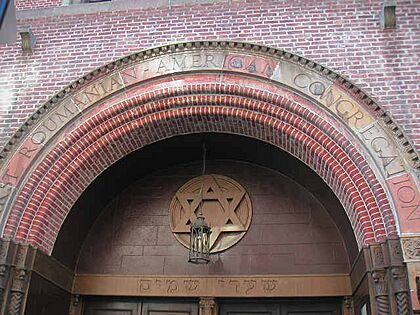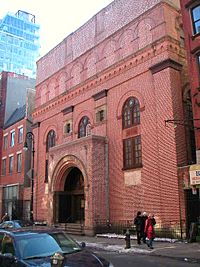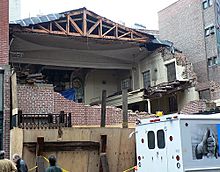First Roumanian-American Congregation facts for kids
Quick facts for kids First Roumanian-American Congregation |
|
|---|---|

Synagogue entrance in 2005, prior to its demolition
|
|
| Religion | |
| Affiliation | Orthodox Judaism (former) |
| Ecclesiastical or organizational status | |
| Status | Closed and demolished (2006) |
| Location | |
| Location | 89–93 Rivington Street, Lower East Side, Manhattan, New York City, New York |
| Country | United States |
| Architecture | |
| Architect(s) |
|
| Architectural type | Synagogue |
| Architectural style |
|
| Date established | 1885 (as a congregation) |
| Completed | c. 1860 (164 years ago) |
| Demolished | March 3, 2006 |
| Specifications | |
| Direction of façade | North |
| Capacity | 1600–1800 |
| Length | 100 feet (30 m)> |
| Width | 70 feet (21 m) |
| Materials |
|
The First Roumanian-American Congregation was a special Orthodox Jewish place of worship. It was also known as Congregation Shaarey Shomayim, which means "Gates of Heaven" in Hebrew. People also called it the Roumanishe Shul, which is Yiddish for "Romanian synagogue".
This important building was located at 89–93 Rivington Street in the Lower East Side of Manhattan, New York City. A group of Romanian-Jewish immigrants started the congregation in 1885. They wanted a place of worship for the many Romanian-Jewish families living in the Lower East Side.
The building itself was built around 1860. It was first a church, then a synagogue, and then a church again, before the First Roumanian-American Congregation bought it in 1902. They made many changes to it to make it their own.
The synagogue became very famous as the "Cantor's Carnegie Hall". This was because it had a very high ceiling and amazing sound quality. It could also fit up to 1,800 people! Many famous cantors (singers who lead prayers) sang there. These included Yossele Rosenblatt, Moshe Koussevitzky, and Moishe Oysher. Even famous actors like Red Buttons and George Burns were connected to it. Edward G. Robinson had his Bar Mitzvah (a special Jewish coming-of-age ceremony) there.
In the 1940s, thousands of people were members of this synagogue. But over time, many Jewish families moved out of the Lower East Side. By the early 2000s, only about 40 members were left. The building was added to the National Register of Historic Places in 1998, which meant it was recognized as an important historical site. However, the congregation found it hard to keep the building in good shape.
In December 2005, water damaged the building's main support beams. Services had to be moved to the rabbi's mother's living room. Then, in January 2006, the synagogue's roof completely fell in. The building was torn down two months later in March 2006.
Contents
The Synagogue's Beginnings
Coming to America
Between 1881 and 1914, about 2 million Jewish people moved to the United States from Europe. Many of them, about three-quarters, settled in New York City. Most of these families made their home in the Lower East Side of Manhattan.
More than 75,000 of these immigrants came from Romania. In Romania, Jewish people faced unfair laws, violence, and were sometimes forced to leave their homes. There was also an economic problem with poor crop harvests. Because of these difficulties, about 30 percent of all Jewish people in Romania moved to the United States.
A New Home in New York
Romanian Jewish immigrants in New York City often gathered in a specific area. This "Romanian quarter" was a fifteen-block area. It was between Allen, Ludlow, Houston, and Grand streets. This area became very crowded, with 1,500 to 1,800 people living on each block. These immigrants started the First Roumanian-American Congregation.
The exact start date of the congregation is a bit unclear. It might have been a new organization of a group that started in 1860. The synagogue was first located on Hester Street. Later, it moved to Rivington Street, which was right in the middle of the Romanian quarter. It became the main place of worship for the people living there.
The Rivington Street Building's History
The building on Rivington Street was first built around 1860. It was a Protestant church for a German immigrant community. In 1864, it was sold to a German-Jewish congregation called Shaaray Hashomayim. Even though this name was similar to the First Roumanian-American Congregation's Hebrew name, the two groups were not related.
By the late 1880s, most of the German-Jewish community had moved away from the Lower East Side. In 1889, the Shaaray Hashomayim congregation moved to a new location. They sold the Rivington Street building to a group called the New York City Church Extension and Missionary Society. This group bought and built churches and Sunday schools in New York City.
The Church Extension and Missionary Society hired a famous architect named J. Cleaveland Cady. He was known for designing many churches and other public buildings. Cady made big changes to the Rivington Street building. These changes cost about $36,000 at the time. He gave the building a new look with reddish-orange bricks, in a style called Romanesque Revival.
The building was renamed the Allen Street Methodist Episcopal Church. Its goal was to try and attract Jewish immigrants to convert to Christianity. However, this effort was not successful. In 1895, the church's pastor said that very few Jewish people attended their services.
Becoming a Synagogue
Buying and Changing the Building
In 1902, the First Roumanian-American Congregation bought the Rivington Street building. They needed a bigger space because the Romanian-Jewish population in the Lower East Side was growing fast. The property was worth about $95,000 back then.
The congregation raised money from its members to buy the building. To thank those who gave $10 or more, their names were carved into marble slabs near the main prayer area. The largest gift was $500, which was a lot of money at a time when $10 was two weeks' pay.
The congregation hired Charles E. Reid to make many changes to the building. These changes cost $6,000. The goal was to turn the church into a synagogue. They removed Christian symbols and added a Torah ark (a special cabinet for the Torah scrolls) and a bimah (a raised platform for reading the Torah). These were placed at the north end of the main prayer hall.
The building kept its original horseshoe-shaped balcony supported by twelve columns. It also kept the wooden pews with reading shelves. But new steel beams were added to support the ark and bimah. The back wall was rebuilt, and the balcony was made larger. Two skylights were added, one with stained glass and one clear glass over the ark. A shallow fifth floor was also added on top of the fourth floor.
The finished building was about 70-foot-wide (21 m) and 100-foot-deep (30 m). It could seat between 1,600 and 1,800 people. The synagogue was officially opened in late December 1902. It was the largest synagogue in the Lower East Side and the only one in the Romanesque style. It quickly became a very impressive building.
Early Important Events
By 1903, the synagogue was a well-known place on Rivington Street. Because it was so large and important, it often hosted big meetings. In April 1903, a service was held there to honor Gustav Gottheil, a leader in Reform and Zionist movements. A similar service was held for Theodor Herzl the next year.
The Union of Orthodox Jewish Congregations of America (UOJCA) held its third yearly meeting at the synagogue in June 1903. About 100 delegates attended. One important decision was that people should get a civil divorce before a religious one. They also asked congregations with many foreign-born members to get a rabbi who spoke English.
In December 1905, a large meeting was held at the synagogue to protest against violence against Jewish people in Russia. The congregation also gave $500 to help those affected. In March 1909, Orthodox groups met there to oppose a new organization meant to represent all of New York's Jews. In 1913, local residents and business owners met at the synagogue to fight against gangsters in the Lower East Side.
The Rivington Street synagogue was also a popular place for discussing issues important to Romanian-American Jews. In 1905, it held the only memorial service in New York City for John Hay, who had helped Jewish people in Romania. In 1908 and 1916, the synagogue hosted meetings of many Romanian-American Jewish organizations. They discussed forming a federation and raising money to help Jewish people in Romania.
The congregation also did a lot of charity work, especially during Passover. By 1905, they were giving out wagons full of matzos (unleavened bread) to poor Jewish families so they could celebrate the holiday. By 1907–1908, the number of members had grown to 500. The synagogue's school, called a Talmud Torah, had 250 students.
Famous Members
Some members of the synagogue became very famous. These included George Burns and Edward G. Robinson. Robinson had his Bar Mitzvah there in 1906. He later joked that he gave the longest Bar Mitzvah speech in the synagogue's history!
In 1911, the First Roumanian-American Congregation celebrated its ten-year anniversary at the synagogue. Important guests spoke, including Solomon Schechter, a leader of the United Synagogue of America, and William Jay Gaynor, who was then the Mayor of New York City. By 1919, the congregation had grown to 350 families. The school had classes every day with 4 teachers and 300 students.
The "Cantor's Carnegie Hall"
The synagogue's main prayer area had a very high ceiling and was known for its amazing sound quality. It was called "the Cantor's Carnegie Hall" because it was a perfect place for cantorial music. Many of the greatest cantors of the 20th century sang there.
Yossele Rosenblatt, Moshe Koussevitzky, and Moishe Oysher all sang there. Even Jan Peerce and Richard Tucker sang there before they became famous opera singers. Having great cantors was important for synagogues. They relied on money from selling tickets for seats during the High Holy Days, and better cantors meant more people would come.
Red Buttons sang in the synagogue's choir with Rosenblatt in 1927. Almost 70 years later, he could still remember the songs. Buttons was discovered at age eight by a talent scout for Rosenblatt's choir. The scout heard him singing near a "pickle stand" in the neighborhood. Buttons sang in the choir for three years.
Oysher, who was known for making cantorial singing popular, became the synagogue's cantor in 1935. The congregation's membership reached its highest point in the 1940s, with thousands of members. In 1956, Oysher described the First Roumanian-American as "the most orthodox Orthodox synagogue in town." Oysher passed away two years later at age 51.
Rabbi Chaim Porille was the rabbi of the First Roumanian-American Congregation from 1932 to 1962. He was born in 1898 and moved to the United States in 1927. He was also a member of the executive board of the Agudath Harabonim.
Building Changes and Look
Over the years, the First Roumanian-American Congregation made more changes to the Rivington Street building. These included:
- 1916–1917: Adding fire escapes on the sides of the building.
- 1920s or later: Putting in individual theater-style seats in the balcony.
- 1948–1950: Rebuilding the front entrance with new "fireproof steel stairs" and new colored glass windows.
In the 1990s, the front of the building had a large, arched entrance made of brick and stone. This arch was supported by carved columns. The words "First Roumanian-American Congregation" were carved into the arch in English.
Originally, there were large rectangular windows on the ground floor, but these were later filled in with bricks. The windows on the second and third floors were once stained glass but later became clear glass. The building's sides were made of plain brick, with narrow alleys and iron gates. Inside, the building had a two-story main prayer area with balconies, and a dining room. The front ark and wooden bimah in the sanctuary were very fancy. The ark was decorated with red velvet, and the bimah had a large bronze candelabra.
Seen in Movies and Music
The synagogue building can be seen in the 1956 film Singing in the Dark, which starred Cantor Oysher. The entrance of the building is also visible in a panoramic photo on the Beastie Boys' 1989 album cover for Paul's Boutique.
Decline and Collapse
Fewer Members
Over time, the synagogue welcomed people from different Jewish backgrounds, not just Romanian-American Jews. However, the number of members started to decrease in the second half of the 20th century. Many Jewish families moved out of the Lower East Side to other parts of New York City.
The First Roumanian-American Synagogue was especially affected. Since it was an Orthodox congregation, members needed to live close enough to walk to Sabbath services. In 1980, it was one of the few synagogues in the Lower East Side that still had its own Talmud Torah (religious school). This school was in a small building next to the synagogue. The congregation eventually had to sell that building.
Rabbi Mordecai Mayer, who had led the congregation for 20 years, passed away in 1981. He was followed by Rabbi Jacob Spiegel.
In the early 1990s, the congregation could still gather the required ten men for the minyan (a quorum for prayer). Local business owners would attend morning and evening prayers before opening and after closing their shops. But by 1996, there were only about two dozen members left. Rabbi Spiegel started holding services in a small social hall in the basement because the main sanctuary was too expensive to keep up.
As the number of members went down, the building started to fall apart. In 1997, the congregation received money to help repair the building. The next year, they received $4,000 for roof repairs. That same year, the synagogue building was listed on the National Register of Historic Places.
Rabbi Jacob Spiegel passed away in 2001. His youngest son, Rabbi Shmuel Spiegel, took over leading the synagogue. In June 2003, the corner of Rivington Street and Ludlow Street near the synagogue was named "Rabbi Yaakov Spiegel Way" in his honor. The roof had been in bad shape for a long time. In December 2001, Shmuel Spiegel raised $25,000 for emergency repairs. Even with these efforts, Rabbi Spiegel sometimes had to look for ten men on the local streets to make the minyan. By 2004, the regular membership was around 40 people. Keeping the synagogue running cost about $75,000 each year.
The Roof Collapses
On January 22, 2006, the synagogue's roof completely fell in. This caused serious damage to the main prayer area. Luckily, no one was hurt. A celebration was later held to be thankful that no one was injured.
The National Trust for Historic Preservation released a statement about the collapse. They said that "older religious properties, like the First Roumanian-American Synagogue," are "national treasures." They also said that these places need help with repairs and funding to save them.
Amy Waterman, who worked on repairing another synagogue, noted that synagogues like the First Roumanian-American were the first spiritual homes for many immigrants. She said that like New York City's bridges and tunnels, these old buildings will break down if they are not taken care of.
The synagogue had hosted a wedding in October 2005, but the main prayer area had not been used regularly for over 10 years because it was so hard to maintain. Services were held on a lower floor. By autumn 2005, the roof was so leaky that during Yom Kippur (a very important Jewish holiday), people had to pray with buckets to catch the water, even in the basement.
After a contractor found water damage in the ceiling beams in early December, the three Spiegel brothers (the rabbi and his two brothers) started holding services in their mother's apartment. They moved the congregation's 15 Torah scrolls there after the roof collapsed. The synagogue's historic ark was also saved from the ruins.
Because the building was not officially a National Historic Landmark, it was torn down on March 3, 2006. The city said the congregation decided to demolish it. But the synagogue's vice president said the city left them no choice. He mentioned that the cost for demolition could be as high as $1.5 million.
At the time of the collapse, the Spiegel brothers promised that the synagogue would be rebuilt. However, it would be much smaller. By October 2007, all that was left was an empty lot with weeds and broken bricks.
Images for kids
See also
 In Spanish: Primera congregación rumano-estadounidense para niños
In Spanish: Primera congregación rumano-estadounidense para niños






